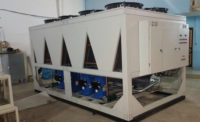If one were to question the use of hydraulic chilled water system modeling to complete an engineering survey, I’d venture to guess most HVAC consulting engineers would not have used this unique, value-added software. And, even fewer engineers will have used it when designing a new project on a multibuilding campus.
Whether it’s engineering a new campus distribution system, reengineering one, or adding an extension to one for a new building on the campus, hydraulic modeling is an essential design tool.
I’ve never had the opportunity to engineer a new central plant with its new campus chilled water system distribution to serve future buildings, whether it was an educational campus, industrial multibuilding site, or a health care multibuilding complex. But, I’ve had the opportunity to complete hydraulic modeling of existing chilled water systems using a couple of different software programs to reengineer several campuses in these three categories.
Many design engineers don’t know what hydraulic modeling is, don’t use it as a design tool, don’t know its benefits, and don’t know the engineering project opportunity to help their customers.
For a campus facility manger, it’s never to late to have this engineering problem-solver completed because:
- it will raise awareness of how the system is operating based on survey findings.
- it will raise awareness of how the system should be operating.
- it will raise awareness of potential energy-saving opportunities.
- it will assist in rethinking and updating the campus master plan as it pertains to available central plant capacity.
The pipe distribution initial survey will provide invaluable operation information, deficiencies in the installation and operation, and potential energy conservation opportunities.
Hydraulic modeling of a chilled water system will help address:
- Design intent by observing when chilled water supply-return delta-T is not being met (e.g., 14°F delta T design versus 9° delta T actual).
- Areas of insufficient chilled water cooling.
- Primary, secondary, and (if applicable) tertiary pump discharge balancing valves by ensuring they are adjusted to a specific “percentage open” (e.g., 70% on primary, 65% on secondary, and 90% on each tertiary pump).
- Variable-frequency drives (VFD) by ensuring are all operating at significantly less-than-100% at peak performance.
Common operating issues found when completing the required pipe distribution survey include undocumented cross-connections between the chilled water supply pipes and the return pipes, terminal unit and/or central air handling unit cooling coil(s) piped backwards, and mixed use of two- and three-way chilled water valves at terminal units
Based on my experience, all of the above have been documented at several campus locations when completing a chilled water distribution survey. Once the survey data had been inputted into the hydraulic modeling software program, the resulting recommendations were significant as to how the system was operating versus how it should be operating. And, the potential improvements had very attractive returns on investments.
Improvements to the operation of the chilled plant could be as simple as rebalancing the entire distribution system. Improvements could be to correct deficiencies, such as incorrectly installed chilled water pipes (e.g., parallel flow in lieu of counter-flow with the air over the coil). Also, knowledge of future central plant growth can now be better understood.
Next month, I will discuss building cooling load diversity versus central plant chilled water campus diversity.





